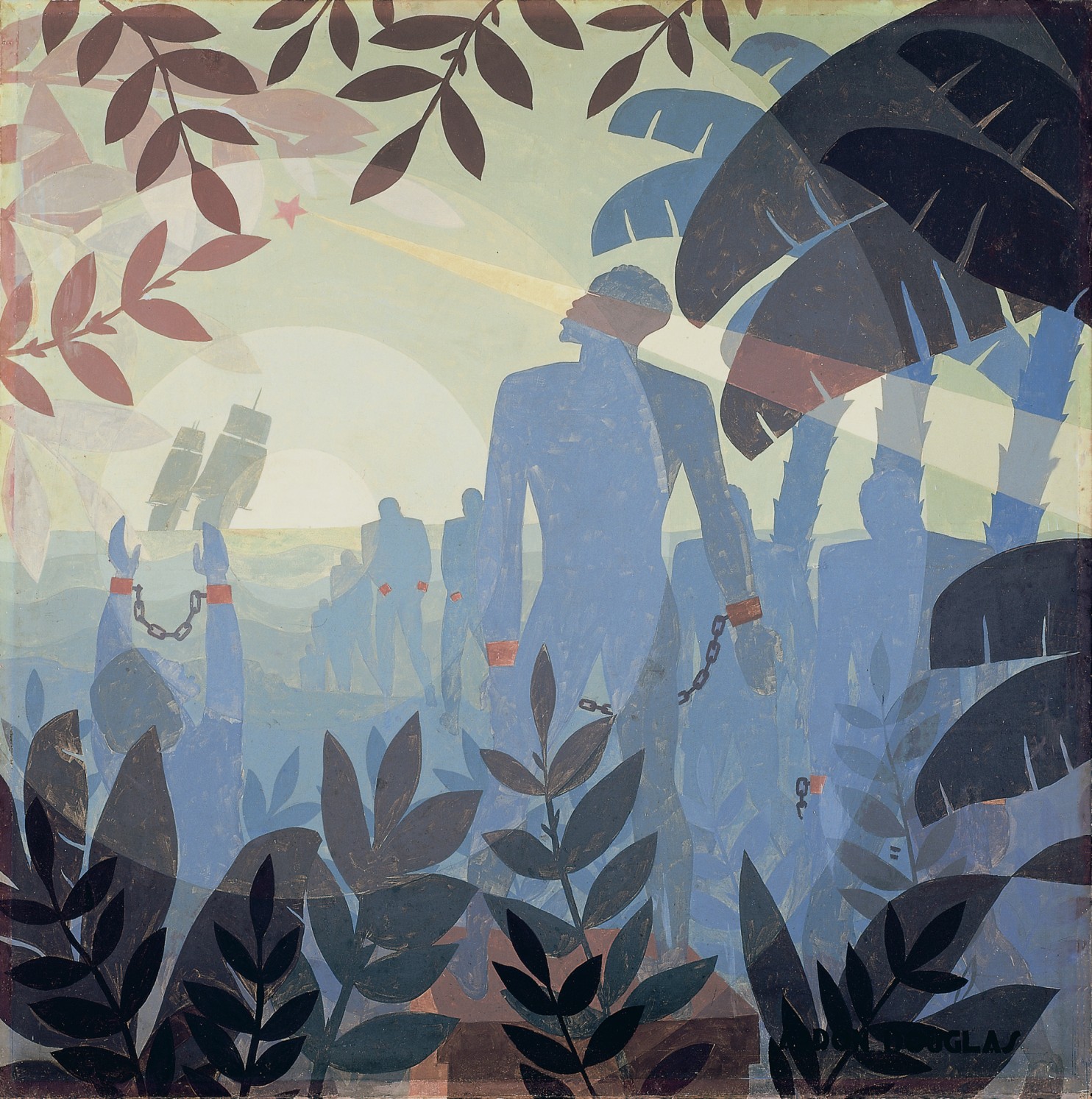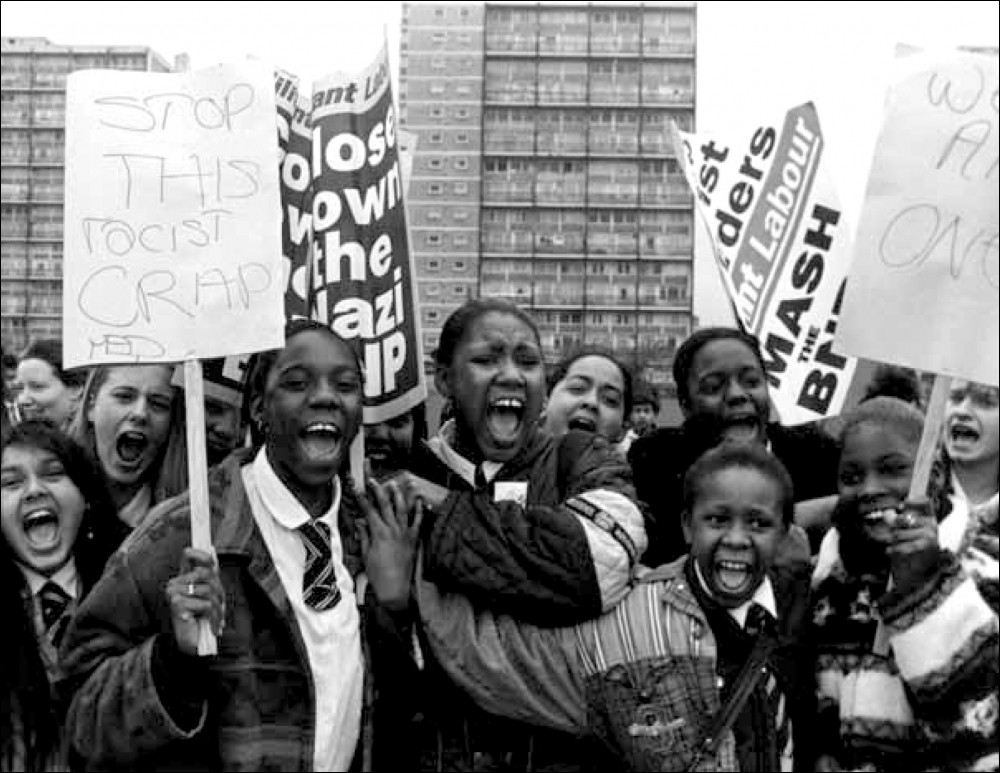
Aaron Douglas ‘Into Bondage’ 1936 (Courtesy of Corcoran Gallery of Art, Washington, DC)
Of all the current dialogues and academic considerations that could be used to interrogate what it means to be white, the notion of Critical Race Theory (CRT) with its emphasis upon the concept of white supremacy is perhaps most appealing. CRT can be seen as an extension of the black gaze as it articulates much of what black scholars, writers, thinkers and artist have been expressing for generations. Critical Race Theory according to Delgado (1995) developed out of Critical Legal Studies in the mid 1970s with the early work of Derrick Bell (an African American) and Alan Freeman (a white American), both of whom were deeply distressed over the slow pace of racial reform in the USA. It seemed to them, that the civil rights movement of the 1960’s had stalled, with many of the gains made in Civil Rights legislation being ‘rolled back’ (Taylor, 2009).
Derrick Bell provides a link between Critical Race Theory and the Black Civil Rights Movement of post World War Two America. One of the first black lawyers to work for the Justice Department, he was asked to resign his membership of the NACCP as it could hinder his objectivity as a member of the Justice Department. Instead, Bell resigned from the Justice Department and took up a post as an assistant counsel for the NACCP’s legal defense and educational fund (www.law.harvard.edu, 2011/10/10). In 1969 he became a faculty member at Harvard Law school, becoming the first black tenured professor in Harvard Law School’s history in 1971. He began a new course in civil rights law, and published his now famous work Race, Racism and American Law (1973). This work arguably laid the foundations of Critical Race Theory with his critique of the racism within the American legal system, developing notions of constitutional contradiction and the interest convergence principle (Bell, [1973] 2008).
Critical Race Theory moves beyond the commonsense understanding of white supremacy as the preserve of extreme racists and situates it firmly in the day-to-day workings of white dominated society. As Crenshaw comments about the emergence of Critical Race theory,
’Critical Race Theory sought to stage a simultaneous encounter with the exhausted vision of reformist civil rights scholarship (…) and the emergent critique of left legal scholarship (…). [CRT’s] engagement with the discourse of civil rights’ reform stemmed directly from our lived experience as students and teachers in the nation’s law schools. We both saw and suffered the concrete consequences that followed from liberal legal thinkers’ failure to address the constrictive role that racial ideology plays in the composition and culture of American institutions…’ (Crenshaw et al. 1995: xix)
According to Ladson-Billings (1998) what this theory provides are the tools with which to expose and interrogate racism in its various forms. Though there is no one-core statement that defines Critical Race Theory, though there are three core themes (Taylor, 2009). The main and perhaps most challenging theme to emerge from CRT is one that regards racism as a ‘permanent fixture’ of society (Ladson-Billings 1998), bringing racism to the center of discussions. For CRT scholars such as Delgado & Stefancic (2001) racism is so entrenched in American society that it is taken for granted and viewed as natural. CRT scholars emphasize that racism does not only necessarily operate in the crude explicit forms of extreme white power groups but operates in a socio-political manner that infuses the everyday fabric of society (Ignatiev,1997, Leonardo, 2004).
Closely tied to this theme of the all pervading power of racism is the notion of interest convergence (Bell, 1973, Taylor, 2009). The line of argument here is that white people have little incentive to work to eliminate racism. However, there are times when the idea of greater equality operates in the interests of white people. The notion of interest convergence helps to explain how such advances in race dialogue have been achieved (Bell, 1973).
The third theme to emerge from CRT is that of storytelling. It places a strong emphasis on the use of narrative and the voice of the black population, their insights into the operation of racism and their understanding of being racially minoritised in order to,
‘add necessary contextual contours to the seeming ‘objectivity’ of positivist perspectives’ (Ladson-Billings, 1998, p.53).
The use of storytelling or counter narrative as a tool for black people, can provide a powerful means of enabling black people the opportunity to ‘speak back’ about racism and facilitate what Tate refers to as ‘psychic preservation’ (Tate 1997, p220); a means for psychological empowerment in response to the debilitating effects of racism.
CRT theorists further express skepticism towards white liberal notions of neutrality or colour-blindness as an approach to challenging ‘race’ issues which, they argue, still underpins white responses. Finally, though CRT can be seen as offering an essentialist paradigm, it does take into account other forms of injustice. The notion of ‘Intersectionality’, as originally proposed by Kimberlé Crenshaw, recognises the complex and multiple ways in which differing systems of subordination can come together at the same time (Crenshaw, 1991).
Criticisms of Critical Race Theory.
CRT has its detractors such as Litowitz, Farber and Sherry (both cited in Taylor, et al 2009) writing from an American legal standpoint and Cole (2009 a, b, c) writing from a Marxist perspective in Britain. Cole (2009b) provides a nuanced critique of CRT in which he disagrees with its central tenet of racism as permanent and central within society. While acknowledging some of CRT’s strengths (p.47), Cole argues that the term white supremacy ‘homogenise all white people together as being in positions of power and privilege’ (2009b, p.25) and does not adequately explain ‘non colour-coded racism’ (p.25). Further, Cole argues that CRT can shift attention away from ‘modes of production’ (p.25) and that it is counter-productive as a political rallying point (p.25). Cole aligns himself more closely with Critical Legal Studies (the progenitor movement of CRT), pointing to ‘its location in economic and social class analysis’ (p.153). Though critical of CRT, Cole wants to open and continue dialogue between Marxist and CRT scholars in developing a common ground for working on ‘race’. CRT scholar Mills (2009) in response to Cole, suggests that a Marxist version of CRT is possible, identifying the emergence of ‘race’ and white supremacy in the history of European imperialism and capitalism. For Mills it is possible to accept a class-based analysis that recognizes that ‘race’ was constructed for the purposes of the project of imperialism and as such can and should be interrogated in its own right (Mills, 2009).
For all of Cole’s well-developed arguments, and calls for unity and dialogue, I feel that he, like other CRT critics have missed the point about CRT. CRT is first and foremost an articulation of the position and situation that black American’s in particular and black people generally experience living in white dominated societies. Its evolution came from the despondent pace of the American legal system in enacting the Civil Rights legislation fought for by African American since the end of slavery. This is why on this website pre-eminence is given to the black gaze and CRT, to demonstrate and emphasize the particular and essential observations on whiteness and white supremacy as discussed by black people. Essentialism is precisely what makes CRT so appealing, for CRT’s essentialism can be used strategically (Spivak and Harasym, 1990) as the catalyst to help focus attention upon living in a white supremacist society.
Finally, regarding such criticism of CRT as that espoused by Cole & Maisuria (2007) in the UK and Darder & Torres (2004) in America and others, Apple (2006b), suggests that,
‘White scholars who think that everything of central importance can be fully understood by somehow merging race as a set of historically determined and determining relations and realities into a relatively economistic understanding of Marx – and here I must speak bluntly – risk practicing a form of whiteness themselves, a form that is based on a privileged position of being white in our societies’ (Apple, 2006a, p. 686).
Similarly, Ladson-Billings warns against CRT being appropriated by a largely white teacher workforce. She compares this to the failure of multiculturalism in education to fulfill its potential through white teacher appropriation,
‘Rather than engage students in provocative thinking about the contradictions of US ideals and lived realities, teachers often find themselves encouraging students to sing ‘ethnic’ songs, eat ethnic foods, and do ethnic dances. Consistently, manifestations of multicultural education in the classroom are superficial and trivial ‘celebrations of diversity’ (Ladson-Billings, 1998, p.64).
Bearing in mind these warnings about Critical Race Theory, its application, at least for this website and for the study of ‘race’ in in general, provides new ways of thinking about race inequalities. For example, differences in the educational achievement of racial or ethnic groups are often blamed on cultural differences. CRT enables the opportunity to focus attention on institutional racism and the ways in which white people are ensconced in a kind of ‘white racial preferencing’ (Roman, 1993, McIntyre, 1997).
White supremacy
White supremacy in everyday parlance is associated with the material violence of groups such as the Ku Klux Klan and the British National Party. According to Critical Race Theorist, the notion of white supremacy within Critical Race Theory offers an all pervading notion of how white racism infuses, directs, situates and positions white people at the expense of their constituent and constructed black Other. As Ansley’s comments,
‘[By] ‘white supremacy’ I do not mean to allude only to the self-conscious racism of white supremacist hate groups. I refer instead to a political, economic, and cultural system in which whites overwhelmingly control power and material resources, conscious and unconscious ideas of white superiority and entitlement are widespread, and relations of white dominance and non-white subordination are daily re-enacted across a broad array of institutions and social settings’ (Ansley, 1997, P.592).
White supremacy in these terms is far reaching in its effects. It can be seen as being part of the structures and institutions of the state, which perpetuate the normalisation (Foucault, 1979) of white discourse. White supremacy re-writes history and sets up a colour -coded hierarchy of humanity in its exercise of power. Its tools are common sense and stereotyping, reinforced at both a macro and micro level.
This may seem an extreme stance to adopt, especially for white liberals to consider; that every little detail, every act and thought of being white is guided and underscored by domination, exploitation, and cultural arrogance (Giroux, 1992; Giroux & McLaren, 1994; Rodriguez, 2000; Levine-Rasky, 2000a; Leonardo, 2004, Solomon et al, 2005). It is an avenue that needs to be explored, for as hooks points out,
‘When liberal whites fail to understand how they can and/or do embody white-supremacist values and beliefs even though they may not embrace racism as prejudice or domination (especially domination that involves coercive control), they cannot recognise the ways their actions support and affirm the very structure of racist domination and oppression that they profess to wish to see eradicated’ (hooks, 1990, p.113).
It could be argued that those of us who are seeking a positive sense of being white need to take heed of hooks and develop strategies that enable us to confront our deep-rooted, often unnoticed white supremacist advantage and how we are actively involved in its reproduction (McIntosh, 1988).
If white racism is a ‘cultural secret’ (Berlak, 1999), circumvented through processes of colour-blindness and avoidance (Lewis 2001; Pollock 2004b), combining the notion of the black gaze with Critical Race Theory isolates whiteness and in isolating it makes it apparent. Interrogating whiteness in isolation can help realign attention, uncover the ‘secrets’, of what it means to be white and how this meaning is predicated upon negative notions of blackness.
See Booklist in ‘Culture’ section for the bibliography of books used in this article

 A Dedication
A Dedication